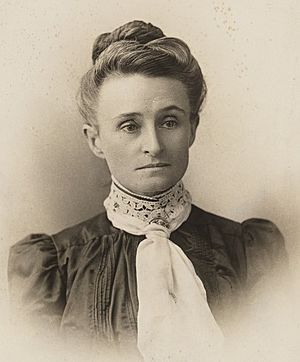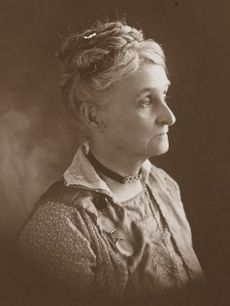Edith Cowan facts for kids
Quick facts for kids
Edith Cowan
|
|
|---|---|

Cowan in c. 1900
|
|
| Member of the Legislative Assembly of Western Australia for West Perth |
|
| In office 12 March 1921 – 22 March 1924 |
|
| Preceded by | Thomas Draper |
| Succeeded by | Thomas Davy |
| Personal details | |
| Born |
Edith Dircksey Brown
2 August 1861 Glengarry station, near Geraldton, Western Australia |
| Died | 9 June 1932 (aged 70) Subiaco, Western Australia |
| Resting place | Karrakatta Cemetery |
| Political party | Nationalist |
| Spouse |
James Cowan
(m. 1879) |
Edith Dircksey Cowan (born Brown; 2 August 1861 – 9 June 1932) was an amazing Australian who worked hard to make life better for women and children. She is famous for being the first woman in Australia to become a member of parliament. This means she was the first woman elected to help make laws for the country. Since 1995, you can see her picture on the back of Australia's 50-dollar note.
Edith was born on a sheep farm called Glengarry, near Geraldton, Western Australia. Her grandparents were some of the first people to settle in the area. When Edith was seven, her mother passed away. She then went to a boarding school in Perth. By the time she was 15, both her parents had died. She lived with her grandmother in Guildford, Western Australia until she got married at 18. Edith and her husband had five children. They lived in West Perth and Cottesloe.
Edith Cowan was a true pioneer. In 1894, she helped start the Karrakatta Club. This was the first social club just for women in Australia. She was a big part of the women's suffrage movement. This movement helped women in Western Australia get the right to vote in 1899. Edith also strongly believed in public education and protecting children. She especially cared about children whose mothers were raising them alone. She was one of the first women to join a local school board. In 1906, she helped create the Children's Protection Society. This group worked hard to create the Children's Court in 1907. Edith also helped start the Women's Service Guild in 1909. In 1911, she helped set up a state branch of the National Council of Women.
Edith was very important in building the King Edward Memorial Hospital for Women. This hospital opened in 1916, and she joined its advisory board. She became a judge in the Children's Court in 1915. In 1920, she became a justice of the peace. This meant she could help with legal matters. In 1921, Edith Cowan was elected to the Legislative Assembly of Western Australia. She was part of the Nationalist Party. This made her Australia's very first female politician! She served one term and worked hard to pass new laws.
Contents
Edith's Early Life
Edith Cowan was born on 2 August 1861. Her birthplace was Glengarry, a sheep station near Geraldton, Western Australia. She was the second child of Kenneth Brown, a farmer. Her mother was Mary Eliza Dircksey Wittenoom, a teacher. Edith's mother passed away in 1868 when Edith was only seven years old. After this, Edith went to a boarding school in Perth. The school was run by the Misses Cowan, who were sisters of her future husband.
After her father died in 1876, Edith left boarding school. She moved to Guildford to live with her grandmother. There, she was taught by Canon Sweeting. He was a former headmaster of Bishop Hale's School. He had taught many important men. Edith learned a lot from him. His teaching made her believe strongly in the value of education. It also made her love books and reading for her whole life.
Making a Difference in the Community
Edith became very interested in social problems. She wanted to fix unfairness in the legal system. She especially cared about women and children. In 1894, she helped start the Karrakatta Club. This was a group where women could learn and grow. Edith later became the club's president. The Karrakatta Club played a big part in helping women get the right to vote in 1899.
After 1900, Edith focused on helping people in need. She cared a lot about women's health. She also wanted to help children who were struggling. She joined many women's and welfare groups. She worked on many committees. The King Edward Memorial Hospital for Women in Perth was built in 1916. This was largely thanks to her hard work. She helped form the Women's Service Guilds in 1909. She also helped start the Western Australia branch of the National Council of Women. She was president of this group from 1913 to 1921.
Edith believed that children should not be treated like adults in court. So, she started the Children's Protection Society. This society was very important in creating children's courts. In 1915, she was appointed to be a judge in the new Children's Court. She worked in this role for 18 years. In 1920, she became one of the first female Justices of the Peace.
During World War I, Edith helped collect food and clothes for soldiers. She also helped care for soldiers returning home. She led the Red Cross Appeal Committee. For her efforts, she was given an award in 1920. She was made an Officer of the Order of the British Empire (OBE).
In her later years, Edith went to an international conference for women in the United States in 1925. She helped start the Royal Western Australian Historical Society in 1926. She also helped plan Western Australia's 1929 Centenary celebrations. Even though she became ill, she kept working on social issues.
What Community Groups Did Edith Join?
Edith Cowan was a Member of Parliament. But she also served on many other boards and committees in Western Australia. In 1929, a newspaper called The West Australian listed some of them:
- Perth Hospital Board
- King Edward Maternity Hospital Advisory Board
- Chairman of the Perth Hospital Red Cross Auxiliary
- President of the Military Nurses Home committee
- President of Pageantry and sights committee -- WA Historical Society
- Vice President of WA League of Nations Union
- Red Cross division committee
- Children's Protection Society
- Town Planning Association
- Housewives Association
- Infant Health Association
- WA Historical Society
- Nationalist Party Executive
- Governor of St Mary's Church School
- General and Provisional Synods of the Church of England
- Bush Nursing Association
- Centenary Committee
- Women's Immigration Auxiliary
- Girl Guides Council
- Karrakatta Club
- Western Australia National Council of Women
Edith's Political Career
In 1921, a new law in Western Australia allowed women to run for parliament. Edith was 59 years old. She decided to run as a candidate for the Nationalist Party. She wanted to represent the West Perth area in the Legislative Assembly. She felt that important issues about homes and families were not getting enough attention.
She won a surprising victory! She beat the Attorney General, Thomas Draper. He was the one who had introduced the law that allowed her to run. Edith Cowan became the first woman ever elected to an Australian parliament. While in parliament, she fought for women's rights. She helped pass a law that allowed women to work in the legal profession. She also made sure mothers had equal rights with fathers if their children died without a will. Edith was also one of the first people to suggest sex education in schools. She lost her seat in the 1924 election. She tried to win it back in 1927 but was not successful.
Edith's Family Life
On 12 November 1879, when she was 18, Edith married James Cowan. He was the Registrar of the Supreme Court. For most of their lives, they lived at a house called Scotstoun in West Perth. They also had one of the first houses in Avonmore Terrace, Cottesloe. They lived there from 1896 to 1912.
Edith was married in St George's Cathedral, Perth. She was also one of the first women elected to the Anglican Synod in 1916. This was a church council.
Death and Burial
Edith Cowan was sick for a long time. She passed away from pancreatic cancer on 9 June 1932. She was 70 years old. After a small service at St. Mary's Church, a large public funeral was held. She was buried at Karrakatta Cemetery.
Edith's Lasting Impact

Two years after Edith died, the Edith Cowan Memorial Clock was put up. It stands at the entrance to Perth's Kings Park. Many people believe this was the first public monument built to honor an Australian woman. Some people at the time were against building it.
In 1975, her picture was on an Australian postage stamp. It was part of a series called "Australian Women." Australia Post honored Edith again in 2021. This was for the 100th anniversary of her election as Australia’s first woman politician. In 1979, a special plaque was placed in St Georges Terrace to honor her.
In 1984, a federal area for voting was named the Division of Cowan after her. In 1991, a college in Western Australia was renamed Edith Cowan University (ECU).
Her picture is on the Australian fifty dollar note. This is a special plastic banknote that first came out in 1995. In 2019, a new version of the $50 note was released. People noticed that the word 'responsibility' in Edith Cowan's speech was spelled wrong! It was missing the last 'i'. In 1996, a plaque honoring her was placed in St George's Cathedral, Perth. There are also references to her in the Centenary of Western Australian Women's Suffrage Memorial in Kings Park. A tapestry was hung in King Edward Memorial Hospital in 2000. It honors the women who helped the hospital.
In 1991, Edith Cowan University bought the house where Edith and her family lived. They lived there for about 20 years. The house was rebuilt on the university's Joondalup campus. It opened in 1997 as Building 20. Today, it is home to the Peter Cowan Writer's Centre.
Edith Cowan was added to the Victorian Honour Roll of Women in 2001. Her life story was made into a play in 2020. It was called "With Fire in Her Heart: the Edith Cowan Story."
Images for kids
See also
 In Spanish: Edith Cowan para niños
In Spanish: Edith Cowan para niños








